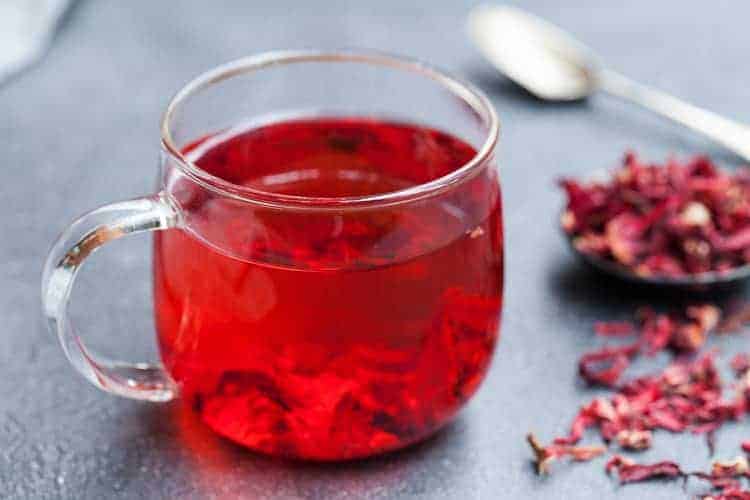
From rosemary and green/black tea, to henna and bhringraj, using tea rinses for hair growth can totally change the way you think of “hair care.” Not only can some of these teas help to stimulate growth, but they can also reduce shedding, breakage, dandruff and itchy scalp.
To help you get started with tea rinses for hair, this guide is going to cover:
- The top tea rinses that support hair growth.
- The side effects of black and green tea rinses.
- How to use tea rinses, plus recipes you can add into your hair care routine.
Now, without further delay, let’s get into these teas!
Note: excessive shedding and thinning of hair often has underlying nutritional and hormonal imbalances. So, while tea rinses may help, be sure to work with your doctor to determine the underlying cause and make appropriate dietary or lifestyle changes. Furthermore, this post contains some affiliate links and I earn a commission (at no additional cost to you) if you use them to make a purchase.
BEST TEA RINSES FOR HAIR GROWTH: BENEFITS AND USES
1. Green and Black Tea
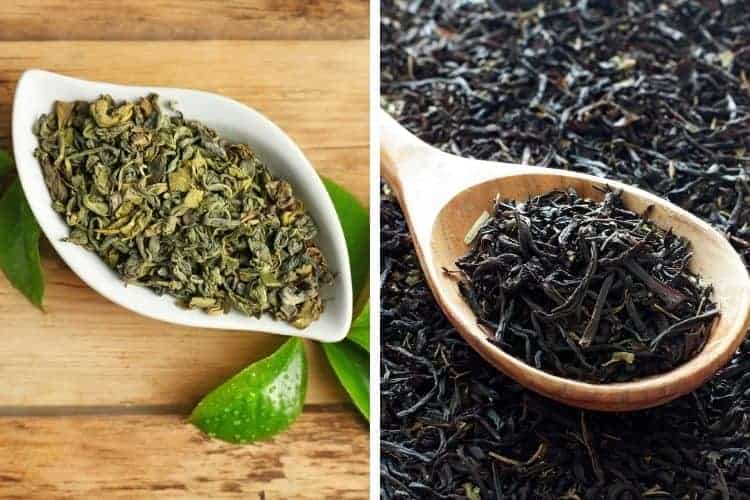
Green and black tea are rich in caffeine, which has been shown to elongate the active growth (aka anagen) phase of the hair growth cycle. In addition, a study comparing a caffeine-based liquid with minoxidil (a common treatment for male pattern baldness) found caffeine to be just as effective, while producing less side effects (1, 2).
One reason why caffeine has this positive effect on hair growth is that it seems to block DHT (dihydrotestosterone). Now, if you’re not familiar with DHT, here’s a very quick rundown:
- DHT is a metabolite of testosterone.
- When present in excess amounts, DHT can shrink hair follicles.
- Not only does the shrinkage of hair follicles negatively affect the hair growth cycle, but it also means that the hair that does manage to grow out tends to be weaker and more brittle (source). Interestingly, this effect seems to only be related to follicles on the head; DHT promotes hair growth in other parts of the body.
So, by using something that counters DHT – such as caffeine-rich teas – you may start noticing improvements in your hair growth and strength.
Furthermore, black and green tea contain saponins, which are natural antifungal compounds.
These saponins may also be beneficial in cases where there is a fungal infection of the scalp.
Lastly, anecdotal reports show that green and black tea rinses are most effective when there is excessive shedding or breakage.
By the way if you’re not clear on the difference between shedding and breakage:
- Shedding is when hair falls out at the root. If you look at the hair strand you will see a white “bulb” at the end of the strand.
- Breakage is when hair breaks off at any point along the length of the strand. This is often due to tangles, knots, damage or dryness.
Aside from everything mentioned above, green tea has additional properties that make it particularly nourishing for the scalp and hair. For example, green tea is:
- Rich in antioxidants that support scalp and follicle health.
- Anti-inflammatory, which means using it topically may soothe inflammatory scalp conditions.
- A natural source of beta-carotene, vitamin C, vitamin B2 (it activates other B-vitamins like B3 and B6, which are essential for hair growth).
2. Amla (Indian Gooseberry)
- Ayurvedic herb that supports scalp health and strengthens hair strands.
- Balances blood flow to the scalp.
- A good, dye-free alternative to henna.
- Rich in C, antioxidants (like polyphenols), minerals and proteins.
- Thickens the diameter of hair strands and increases the number of hair strands.
- Used as a natural remedy for slowing down greying.
3. Bhringraj
- Ayurvedic herb that is known as the king of herbs.
- In a rat study comparing bhringraj extract with 2% minoxidil (a common hair loss treatment), bhringraj was shown to stimulate initial hair growth twice as fast as minoxidil. In addition, bhringraj also significantly reduced the time required for complete hair growth (source).
- Supports the production of keratinocytes, which are the cells that make keratin (source). This is majorly important for hair growth because keratin is the main protein in hair strands.
- Natural remedy for dandruff and for slowing down greying.
4. Cassia
- Ayurvedic herb that is said to condition and strengthen hair.
- Soothes dandruff.
- Often used as a natural hair dye (it provides a yellow color, but this effect is minimal when using it as a tea).
- Protects hair strands from UV damage (source).
5. Henna
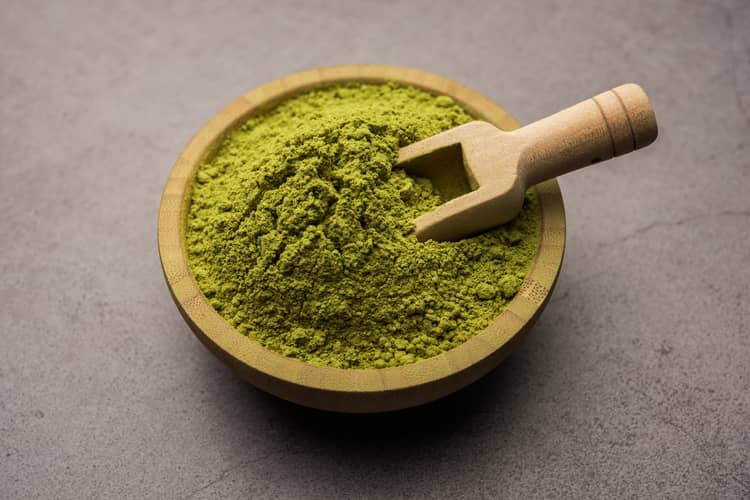
- Ayurvedic herb that is traditionally used as a hair dye (imparts reddish tones).
- In a study comparing henna with impatiens balsamina (garden balsam) both plants were found to promote hair growth and increase hair density. But henna had a stronger effect. The study theorized that henna may work by reducing androgens locally in scalp tissue (source).
- Potent hair conditioner and strengthener.
- Penetrates the hair shaft and helps to temporarily seal damaged areas.
- Has cooling, astringent, antifungal and antibacterial properties (source).
NOTE: henna can be drying so consider combining it with other moisturizing ingredients.
6. Hibiscus
- The leaves and flowers are traditionally used in Ayurvedic hair care.
- Long-term use helps to cover grey hair.
- Natural source of proteins.
- Contains mucilage which adds slip to the hair and reduces tangles.
NOTE: the amount of mucilage in hibiscus seems to vary from one variety to another. Hibiscus sabdariffa – which is what is commonly sold in U.S. herb stores – may not have as much mucilage as other varieties like hibiscus rosa-sinensis.
7. Aloe Vera (powder)
- Often used in Ayurveda, aloe contains vitamins (like A, C and E), minerals (like zinc and selenium) as well as amino acids which are the building blocks of the proteins that we need for healthy hair.
- Has humectant properties that help to draw moisture to the hair.
- Contains antiseptic and anti-inflammatory compounds that are very soothing to dry, itchy, irritated or inflamed scalp.
8. Brahmi
- Traditionally used in Ayurveda for its ability to thicken hair and stimulate growth.
- Contains alkaloids that seem to activate the proteins that are involved in hair growth.
- Used as a natural remedy for dandruff.
9. Rosemary
- Traditionally used to stimulate blood flow to the scalp and promote hair growth.
- Anti-inflammatory and antimicrobial.
- Natural remedy for dandruff and other inflammatory scalp conditions.
10. Fenugreek Seeds
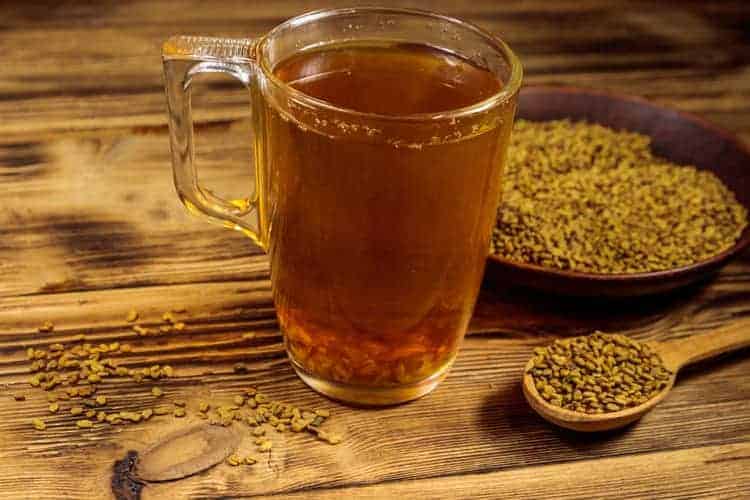
- Ayurvedic herb that is rich in hair-strengthening proteins.
- Promotes blood flow to the scalp.
- Rich in mucilage.
- Can be used for dandruff and for strengthening dry or damaged hair.
NOTE: some people find that the protein in fenugreek can be a little drying. So, consider combining fenugreek with other moisturizing ingredients or simply use it less frequently.
11. Nettle
- Rich in minerals, vitamins, proteins and iron.
- Supports hair growth by blocking 5-alpha-reductase (the enzyme that converts testosterone to DHT).
- Acts as an astringent, making it a good match for oily scalps or hair.
12. Peppermint
- Improves blood flow to the scalp which helps to stimulate hair follicles.
- Has antibacterial and anti-inflammatory properties – thanks to ingredients like menthol – that make it very soothing for an inflamed scalp.
- Contains volatile oils (essential oils) that have been studied for their positive effects on hair growth.
For more on this herb, read this guide on how to use peppermint tea for hair.
13. Chamomile
- Conditions hair strands and soothes inflamed scalp.
- Known for bringing out the natural highlights in blonde hair.
- Provides a natural shine or sheen to hair.
14. Marshmallow Root
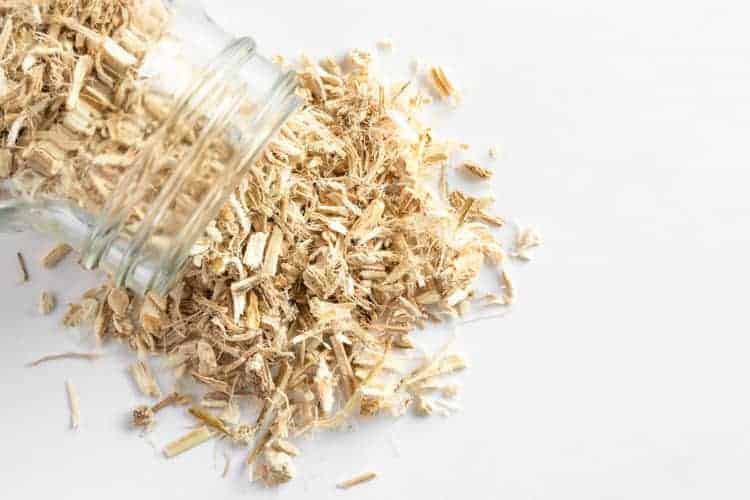
- Very high in mucilage which adds a lot of slip to the hair and facilitates detangling.
- Natural source of strengthening proteins.
- Conditions and softens hair.
15. Dandelion
- the root or the leaves can be used in a tea.
- both parts of the plant are good sources of nourishing vitamins and minerals, as well as antioxidants.
- naturally anti-inflammatory and can be soothing to a sensitive scalp.
SIDE EFFECTS OF BLACK AND GREEN TEA ON HAIR
Depending on your hair type, you may find that your hair feels very dry after using a black or green tea rinse.
This effect is more pronounced with black tea because it has more caffeine (but it can also happen with green tea).
To counteract this dryness, try the following tips:
- use decaffeinated tea so that your strands are not exposed to a lot of caffeine. Decaf black tea contains 2 mg of caffeine per cup which is far less than the 28 mg in regular green tea or the 47 mg in regular black tea (source).
- add a humectant like glycerin or honey into the tea. This will help to draw moisture to your hair.
- use a moisturizing conditioner after applying the tea.
- rather than pour the tea over your entire head, put it in an applicator bottle or spray bottle. Then focus the application of the tea to your scalp only.
- use the rinse only as needed. Some people use it weekly to reduce shedding and then stop after about a month (it tends to work fast and doesn’t have to be used all the time).
HOW TO USE TEA RINSES TO STIMULATE HAIR GROWTH
1. As a leave-in
Leaving a tea rinse in your hair gives your scalp and strands time to soak up the goodness. Here’s how to use it.
- Brew your tea and let it cool down. Then place the tea in a spray bottle.
- On days when you wash your hair, spray your scalp and hair strands after shampooing and deep conditioning (if applicable). Massage the tea in. Proceed with your usual leave in conditioner or styling products.
- For days when you’re not shampooing your hair, simply refresh your hair by spraying the tea onto your scalp and strands. Do this every other day.
NOTE: this should only be done with herbal teas. Don’t try this leave-in approach with black or green tea since they’re very drying.
2. As a wash off rinse
You can either:
- Spray your hair with the tea, leave it on for about 15 minutes, then rinse it off.
- Another option is to pour all the tea on your head and massage it in. Apply conditioner on top of it and rinse after 15 minutes. NOTE: you can place a large bowl underneath your head to catch the excess tea. Then pour this over your head again. This gives you two rinse cycles so that you can be sure to cover every part of your head with the tea.
TEA RINSE RECIPES TO SUPPORT HAIR GROWTH (AYURVEDIC, HERBAL AND GREEN/BLACK TEA)
1. Itchy Scalp Tea Rinse
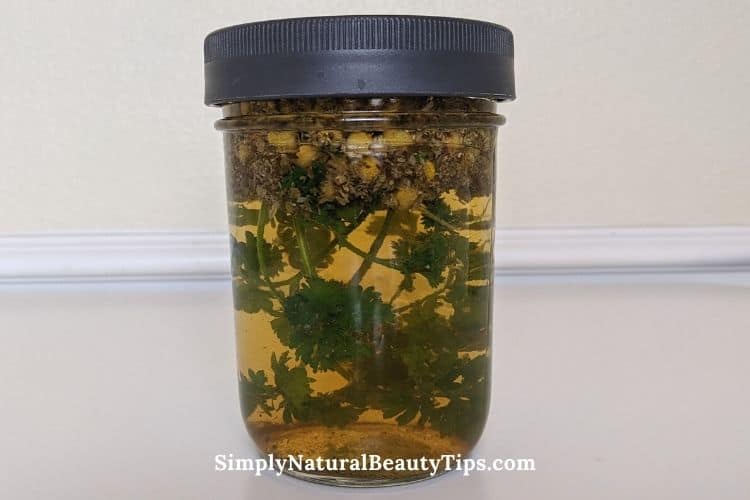
Ingredients
4 sprigs of fresh parsley (or 1 Tbsp dried)
2 Tbsp dried chamomile flowers
1 tbsp dried oregano leaves
12 ounce mason jar
Instructions
- Place the herbs in the mason jar.
- Pour freshly boiled, distilled water over the herbs.
- Use a spoon to stir and fully submerge the herbs.
- Seal the jar.
- Allow the herbs to steep for 4 hours (or for a stronger tea, steep overnight).
- Strain the herbs using a strainer and cheesecloth (to catch those stubborn bits).
- Transfer the tea to a spray bottle.
- Store in the fridge for up to 7 days.
2. Ayurvedic Rinse for Hair Growth Stimulation
Ingredients
1/2 Tbsp fenugreek seeds
1 Tbsp amla powder
1 Tbsp henna powder
1 Tbsp rosemary
12 ounce mason jar
Instructions
- Place the herbs in the mason jar.
- Fill the jar with warm (not boiling), distilled water.
- Seal the jar and allow the herbs to steep for 8 hours or overnight.
- Strain out the herbs using a strainer and cheesecloth (to catch the powders).
- Place in a spray bottle and use as desired.
- Store in the fridge for up to 7 days.
3. Herbal Rinse for Tangles
Ingredients
Dried marshmallow root
12 ounce mason jar.
Instructions
- Fill the jar 1/4 of the way with marshmallow root.
- Pour lukewarm water into the jar.
- Seal the jar and allow to sit on a countertop for 12 hours.
- Strain out the herbs using a cheesecloth (or nut milk bag) to make sure you grab all the tiny bits. The resulting tea will be viscous and a little thicker than standard tea.
- Place the tea in a spray bottle and spray all over your hair. This is also very soothing to a dry scalp, so don’t hesitate to apply it there as well.
- Store in the fridge for up to 7 days.
NOTE: Depending on your hair, you may or may not notice much of a difference after one use (I have tightly coiled hair, so this acts as a very mild detangler). From my perspective, it’s best to use this regular so that it can nourish your hair in the long-term.
4. Green or Black Tea Rinse for Excessive Shedding and Breakage
Ingredients
2 green tea bags or black tea bags
2 cups boiled water
Instructions
- Steep the tea bags in the water.
- If you’re using regular caffeinated tea, allow it to steep for 5 minutes. Otherwise you can let the tea steep until the water has cooled if you’re using decaf tea.
- To use this tea, you can either pour it all over your head or place it in a spray bottle and spray it on your scalp/strands.
- Let the tea sit on your hair for 15 minutes, then rinse.
- Follow up with a conditioner.
- Use this once a week or every two weeks if you find that caffeine dries out your scalp and strands too much.
FAQs ABOUT USING TEA WATER FOR HAIR
Is a tea rinse a protein treatment?
If your tea rinse uses herbs that are rich in protein – such as fenugreek – then it will also act as a mild protein treatment.
How often should you do a tea hair rinse?
Many herbal tea rinses can be used several times a week. Simply store the tea in a spray bottle and mist your scalp and strands with the tea.
As for green and black tea, these should be used only as needed. Many people notice that their shedding reduces within one or two applications of these rinses. So, once you notice improvements, stop the rinse. And from then on only use it when your hair actually needs it.
Can I leave a black tea rinse in my hair?
Because of its caffeine content – which can be very drying – it’s best not to leave a black tea rinse in your hair. Instead, apply and let it sit on your hair for 15 minutes. Then proceed with a moisturizing conditioner to restore softness to your hair.
CONCLUSION
If you are completely new to tea rinses, I hope that this article has inspired you to give them a try. You can start with just one herb and eventually, start combining the ones that you like best.
Also, keep in mind that there are many other herbs that can be used for rinses, including hops, red clover, basil, calendula and many more.
So, don’t hesitate to experiment as you get more comfortable with these plants!
Lastly, when it comes to Ayurvedic herbs, I suggest getting them from a reputable retailer like Henna Sooq. For all other herbs, definitely look into Mountain Rose Herbs. They have a massive collection of high quality, organically grown herbs to pamper your strands.
You Might Also Enjoy:
How to Mix Essential Oils for Hair Growth: A Step-by-Step Guide with Dilution Chart
Rosemary vs Peppermint Oil for Hair Growth: Which Should You Use?
How to Infuse Herbs In Oil for Hair Growth: Best Herbs and Oils, Fastest Method and DIY Recipe
Best Carrier Oils for Hair Loss and Regrowth: A Complete Guide
What To Mix With Shea Butter for Skin and Hair: Tips and Recipes
DIY Lavender Essential Oil Recipes for Hair Growth & Thickness

